Everyone knows that flowers are essential to bees, but do you know which flowers are best for making honey? There are a number of common plants that are easy to grow for your garden and that bees will love to visit all day long. The flowers of these plant families are rich in nectar for bees to produce a lot of good-quality honey. At the end of this article, you’ll be able to know what flowering plants to grow for bees and when these plants bloom. You can then have a garden that will provide the tiny guys with food throughout the foraging seasons, and allow them to produce plenty of sweet, tasty honey.
What are the best flowers or bees? Flowering plants like Aster, Bachelor’s Button, Basil, Bee balm, Basil, Borage, Clover, Dandelion, Hyssop, Mallow, Mint, and Nasturtium are huge hits with bees for their rich and plentiful nectar. Oregano, Poppy, Rosemary, Sage, Sunflower, and Thyme are beloved by bees too.
Table of Contents
Aster (Aster/Callistephus)
Asters are very common wildflowers composed of more than a hundred species. They come in a variety of colors, usually with yellow centers. They can grow from just 6 inches to up to 4 feet, but their average height is 24 inches. Asters are native to North America and can grow rather quickly.
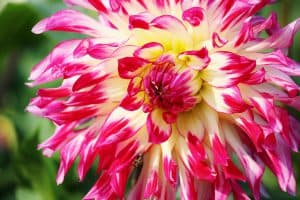
These flowers usually provide food for bees late in the season, usually just before winter starts. They allow bees to weather the cold of winter months, well-fed and strong. Be careful when choosing Asters for your bee garden as some modern hybrids have a small amount of nectar and little to no pollen so check with you local garden center.
Some varieties can be grown from seeds, but the plants are available for sale in nurseries. Asters grow well in full sun and fertile, well-drained soil.
Bachelor’s Button (Centaurea)
These flowers bloom from midsummer to late fall or until the first frost. Centaurea cyanus, C. imperialis are annual bachelor’s buttons that are also known as cornflowers. Cornflowers come in shades of yellow, white, pink and blue. Perennial bachelor’s buttons, on the other hand, only come in blues and whites. This pretty blue color attracts bees quite well.
The interesting name came from an old practice of pinning the flower to lapels of gentleman bachelors courting their ladies.
Bachelor’s Buttons are hardy, cheap, and easy to grow. Give them plenty of sun, regular watering and well-drained soil, and their good to go.
Basil (Ocimum)
Ocimum basilicum or Basil is also sometimes called the king of herbs for its many uses. Not only that, basil quite literally means king, from basileus, a Greek word. The plants have tiny white to purple flowers that attract honey bees well. Basil blooms throughout the summer. They are annual plants that grow quite fast.
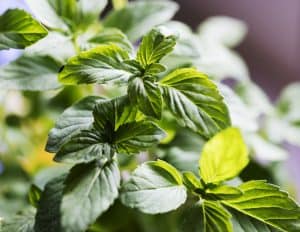
The tricky thing with basil is that you’ll need to pluck the flowers in order for them to continue producing the flavorful leaves. So if you want to add basil to your kitchen too, be sure that you have some specifically for bees that you can just leave alone to flower, and some for your own use where you’ll remove flowers from.
The plant is a little sensitive to the cold, so it’s better to place them in a hot and dry environment. Basil also prefers moist, well-draining soil.
Bee balm (Monarda didyma)
The name says it all. Not only is this plant popular with bees, but its fragrance also attracts other pollinators like small birds and butterflies. Bee balms are even good for you as they are edible and have medicinal properties. They’re also used in herbal teas. In fact, the flower is also known as Oswego tea.
The Bee balm blooms in midsummer as soon as it reaches 18 inches. It will then continue to grow to 3 or 4 feet. Its flowers come in shades of red to purplish red, pink and white.
The Bee balm family also includes Monarda punctata or horsemint, and Monarda citriodora or lemon mint.
Bee balms are mostly perennials that prefer well-drained soil and lots of sun although they can grow quite well under partial shade. These plants can be propagated from seeds but grow even quicker if planted from cuttings.
Borage (Borago officinalis)
Borages are herbs with purple blossoms that bees absolutely love for its easily accessible and plentiful pollen and nectar. The flowers are also completely edible to humans so you and your bees can benefit from this plant. Livestock can even eat the whole plant.
Borages blossom in late spring and all through summer. The nectar excretion of the blossoms will be more bountiful in warm, humid weather and moist soil.
Borages are annual plants that love the sun and can grow up to 2 feet. They would die in the winter but can easily grow again because of the seeds released into the ground. Watch out once the flower starts to change from blue and purple to pink. It means that it’s ready to shed its seeds.
Clover (Trifolium)
Bees love weeds too. They’re just pesky weeds to most people, but if you see them growing in the garden or your lawn, you can leave these plants ‘bee’ from now on. Weeds like clovers are great for bees.
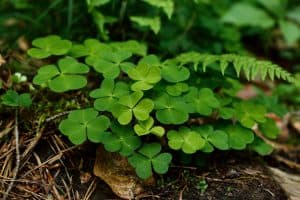
The most common clover is the white clover or Trifoleium repens that usually blooms for several months in spring or summer. Another is a red/crimson kind that’s commonly found in the wild, T. pratense. Clovers are legumes that actually produces its own nitrogen which is not only beneficial to itself but for other plants in the garden too.
Weeds are very hardy and in some ways, truly genetically superior to some other plants we don’t consider as a nuisance. Clovers are tenacious, drought-resistant and grow well in poor soil. If you are a hopeless gardener, especially, then take heart. There’s a growing trend of ‘flower bee lawns’ composed of flowering weeds that are good for bees.
Dandelion (Taraxacum officinale)
Another hated weed that is beloved by bees, and can be a great addition to a flower bee lawn. Its name came from dent de lion, French for lion’s tooth, in reference to the weed’s toothy leaves.
The dandelion’s peak flowering time is during early spring. This is also when bees just emerged from hibernation, in need of nectar. After winter, as long as they can stay alive until the dandelions bloom, the bees will be safe for another year. This makes dandelions extremely important.
Goldenrod (Solidago)
Here’s another weed candidate for that bee lawn. Goldenrod is a honeybee fall favorite, blooming long spikes of yellow blossoms in late summer and fall.
The goldenrod honey, with its dark color and distinctive, slightly spicy bite, is considered a delicacy. Dark honey is said to have more antioxidants than light honey.
Goldenrods are very hardy and can easily become invasive. They can be grown in partial shade and tolerate clay but for a beautiful, healthy bloom, grow them in an area with well-drained soil and lots of sun.
Hyssop (Agastache)
This herb is a good source of pollen, but Hyssop is an even better source of nectar. This makes it a perfect food for bees if you want a healthy production of honey. Bees flock to Anise hyssop because it provides an abundant supply of nectar. Some even think that it adds an anise seed flavor to the honey.
A very common species of the Agastache family is the Anise hyssop or Agastache foeniculum. Its leaves release a licorice fragrance and minty taste when crushed. It blooms from midsummer to late fall with spiky, purple flowers. A. nepetoides is a wildflower of the same family that produces light yellow blooms and thrives in woody areas.
Anise hyssop grows to about 3 to 5 feet tall and can bloom for months. It’s a low maintenance perennial plant that only requires full sun and moist or dry soil.
Mallow (Malvaceae)
Plants from the Malva family are known for having bountiful flowers and for doing well in poor conditions. Malva sylvestris or High Mallow is one of the most common species in this plant family. It produces a wealth of purple blossoms and blooms for about two months from late summer to early fall.
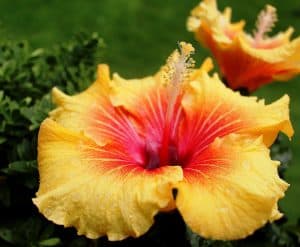
There are about 26 species of Malva, and all of them can easily be nurtured from seed. They prefer partial sunlight and rich, loamy soil.
Mint (Mentha)
From peppermint to chocolate mint, spearmint, apple mint, horsemint and wild mint, bees just love all the mints. Even catmint or catnip that attracts cats so strongly is just as attractive to bees too. They usually bloom in the later part of the year.
Sometimes, people’s problem with mints is not in growing them but in preventing them from spreading too fast and taking over the garden. The best way to grow and contains mints is to keep them in a container. However, if you don’t really care about the kind and variety of the plants you grow (or you don’t have much of a green thumb), as long as bees can feed on them, then mints are one of your best bets.
They can be grown from cuttings or from seed. If you don’t really wish mints to take over the garden, contain them by planting in a pot.
Nasturtium (Tropaeolum minus)
Nasturtiums are lovely plants that come in many different colors. Many of them are two-toned, meaning, the top of the leaf is a different color from its underside. They can be bushy or trailing, perfect for hanging baskets, flower beds or raised bed edges. This plant will continue to bloom until the frost kills it, so bees will be well-fed in preparation for winter.
Nasturtiums are annuals that you can grow from seed or purchased as a grown plant. They don’t like the shade at all so put them in the sun for more flowers to bloom. Nasturtiums grow well in rich soil and can reach 4 feet tall.
Oregano (Origanum vulgare)
Oregano flowers are tiny, colored light purple or pink and are bee favorites. They bloom for the whole month of July.
Not only does oregano benefit bees, but it can also add flavor to your cooking, has valuable antibacterial and antifungal benefits and can even help boost the immune system.
The herb should be planted in well-draining soil and be given plenty of sun, although it doesn’t need a lot of water. Oregano grows easily through seeds, roots, and cuttings.
Poppy (Papaver/Eschscholzia)
Corn poppy (Papaver rhoeas), Iceland poppies (P. nudicaule), Danish flag (P. somniferum), and California poppies (Eschscholzia) are all great pollen producers and provide a fair amount of nectar to bees. Their flowers are open, so pollen and nectar are easy for bees to get too. Their crimson, scarlet and pastel colors are extremely attractive to bees and other pollinators.
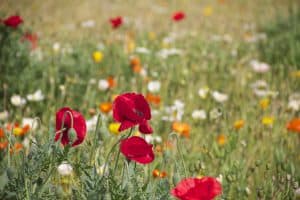
Poppies bloom from summer to fall and are very easy to propagate. They can be transplanted, although you’ll have more success by growing them from seed.
Sage (Salvia officinalis)
There are hundreds of members in the Salvia plant family, and they come in many different colors, from reds to blues and tricolors, to name a few. Sages bloom in summer and produce plenty of nectar for bees to harvest, so you’ll frequently see the tiny insects dancing around their flowers. Aside from honeybees, bumblebees, leafcutter bees and mason bees also flock to these plants.
Sages thrive in full sun and well-drained soil. Most don’t need a lot of water.
Rosemary (Rosmarinus officinalis)
The great thing about rosemary is that this herb has a long flowering season. The bluish purple flowers can start to show up in the spring and continue to bloom for the whole year. Some can even reach winter.
This hardy herb is drought-tolerant and likes full sun and well-drained soil.
Sunflower (Helianthus/Tithonia)
Be careful of pollenless sunflower hybrids if you’re putting a garden together for the benefit of your bees. There are sunflower hybrids with no pollen and little nectar to offer which makes them virtually useless to the bees.
Sunflowers bloom in the summer to early fall. They come in varying heights and warm colors. For some reason, bees are not as attractive to red sunflowers as they are to yellow or orange ones, so keep this in mind when making a selection.
Sunflowers have a long tap root that makes them very drought tolerant plants so they can adapt to different soil types. However, if you want bright, healthy sunflowers that can provide lots of nectar for the bees, this plant ought to be given regular waterings and planted in fertile soil where they can receive plenty of sun.
Thyme (Thymus)
Thyme is another family woody herbs that seem to always be abuzz with honeybees and various other bees and pollinators. Thymes have tiny pink, white and purple flowers that bloom in the summer.
The most common thymes that are good for bees are the common thyme (Thymus vulagaris), lemon thyme (T. citriodorus) and creeping thyme (T. praecox).
Thymes can grow to around 13 inches. They are drought resistant but do best in well-drained soil and under the hot sun. These perennials are propagated by cuttings, seed or root divisions.
Flower Fidelity
Bees exhibit what is called flower fidelity. It’s when they faithfully visit just one kind of flower in the garden for days or even weeks at a time. It is not known exactly why bees do this or how it benefits them. The practice, however, makes pollinating flowers rather easy as the bees transport just one kind of pollen.
In your garden, you can arrange plants together in rows, columns or groups so bees can easily hop from one flower to another and forage efficiently without wasting too much energy.
Different Flowers, Unique Honey
There exist countless honey varieties depending on the bees’ flower source. Each source can contribute to a unique sensory characteristic. Even the soil type, climate and region, etc. can contribute to honey’s uniqueness.
What we are commonly used to is wildflower honey or million-flower honey, made from an unidentifiable diverse mix of flower sources. This is the beauty of honey, as it can vary in color, flavor, and texture depending on the season’s harvest, mirroring the wonderful unpredictability of nature.
But there is actually honey known as uni-floral, single-origin or varietal honey. This bee product is made from bees collecting nectar from primarily one kind of flower. Chestnut honey has a spicy and nutty flavor and can even taste bitter. It is gathered from flowers of the chestnut trees in Italy. Coffee honey is very dark, almost brown and has a rich coffee-toned taste. It’s produced in coffee-growing countries like Ecuador and Colombia. Clover honey is popular and can be found everywhere. It’s a light amber color, almost white and has a mild flavor.
Of course, making sure that bees harvest from only one kind of flower is almost impossible for hobbyist beekeepers. Bees forage within a three-mile radius (4 km)to any direction, sometimes reaching twice this distance. Producing uni-floral honey would require acres of predominantly the same kind of flower surrounding the beehive.
Conclusion
Whether you are building a bee apiary, creating a bee flower garden or just want to be aware of the plants and weeds you should leave alone, you now know what flowers are best for bees when they make honey and will be able to put this knowledge to good use.
